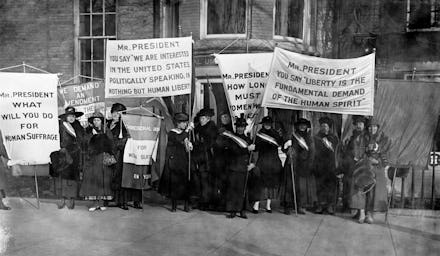This List of the 100 Most Famous People in History Only Has 8 Women on It

It's Women's History Month, meaning the Internet is full of inspiring stories about unsung female heroes and infuriating comments about how devoting 31 days a year to those stories discriminates against men.
But the next time someone complains to you about the lack of a Men's History Month ("It's only fair!"), send them over to Pantheon — an "interactive catalogue of fame" created by the Macro Connections group at the MIT Media Lab — and maybe they'll start to get why "men's history month" would be pretty redundant.
The project, whose website recently went live, is "compiling, analyzing and visualizing datasets that can help us understand the process of global cultural development." In laymen's terms, they're tallying lists of the most famous people to have lived from 4,000 B.C. to 2010 (nearly all of recorded history). And in the rankings of the top 100 most famous people overall, there are only eight women.
Let me repeat that: In a list looking at the 100 most famous figures from the past 6,000 years, only eight women have garnered enough cultural clout to merit a spot.
If ever there were proof of the importance of specifically celebrating women's history, this is it.
For Pantheon's purposes, fame means having a Wikipedia biography in at least 25 different languages, and contributing some sort of "tangible achievement" to the world, whether it be in the realms of art, science, literature, philosophy, media, etc. The project (essentially the biggest popularity contest ever), makes no moral judgments, and includes figures both admirable (Mother Teresa) and otherwise (Elizabeth Báthory).
Image Credit: Pantheon.
Cleopatra is the first woman to make an appearance on the list of most famous figures overall. At #29, she is also the only woman even to crack the top 50. She's followed by Nefertiti (the Great Royal Wife, #51), Joan of Arc (#53), Mary (i.e., Mother of Jesus, #61), Sappho (#78), Mary Magdalene (another Jesus affiliate, #83), Elizabeth I of England (#88) and Anne Boleyn (#91).
Women fare slightly better in a handful of the the project's more specific categories, but the results are largely the same across the board. Two of the categories women most heavily dominate are "Media Personality," and its subset "Pornographic Actress" (a category the New York Times was sure to include in its brief write-up). An outsider looking at these data sets might think that women's biggest historical accomplishments consisted of looking pretty, marrying well and having sex for money. And for the record, the most globally-known woman in media? Paris Hilton.
Image Credit: Facebook
In the list of the top 500 people overall, there are 37 women, which amounts to just 7.4% of the total. Given that women make up about 50% of the population, something is clearly wrong with this picture. But it isn't the project's fault.
Pantheon probably didn't meant to paint such a sobering picture of gender inequality in historiography, but the evidence is clear. While we like to think of historians as objective recorders of events, history is inevitably biased. Decisions about whose stories get told, in what words and how often shape future generations' understanding of the past, and historical narratives have routinely diminished women and their achievements.
So Pantheon's numbers aren't particularly surprising, but that's not because women haven't done anything worth remembering — it's because history has chosen to ignore them.
Pantheon should be celebrated for bringing to light these inequalities. But if we really want to "celebrate our global cultural heritage" going forward, we need to take far more care to allot women's contributions and accomplishments equal space in our history books. If that means rewriting them, then so be it.